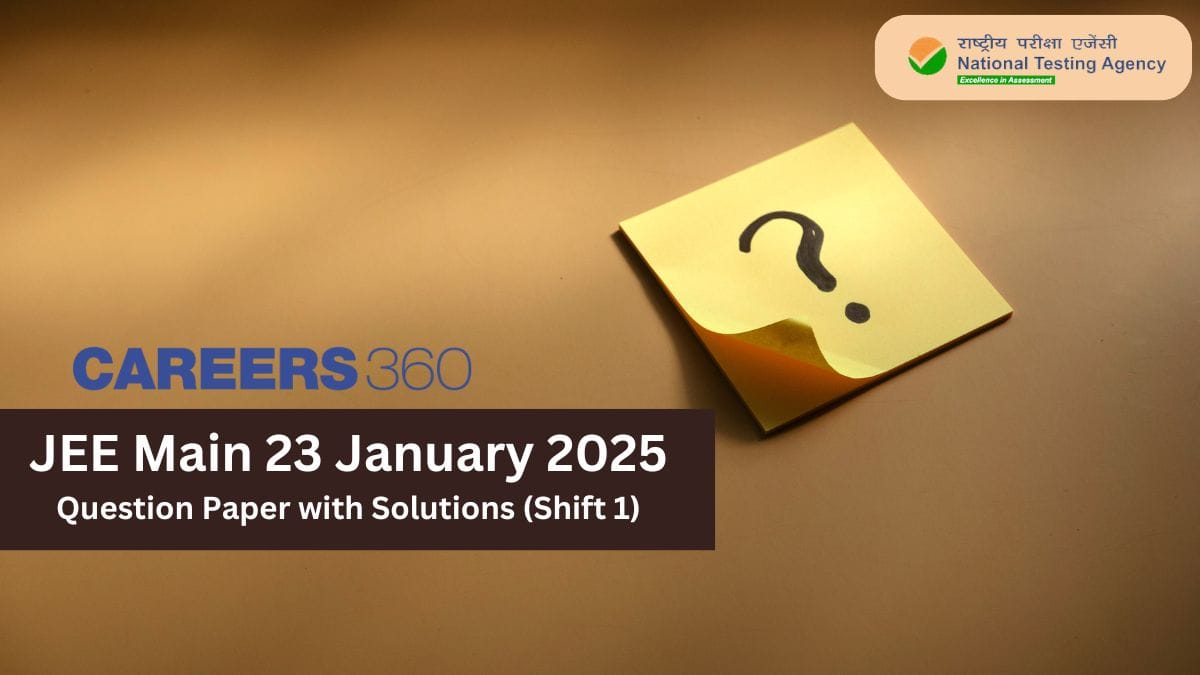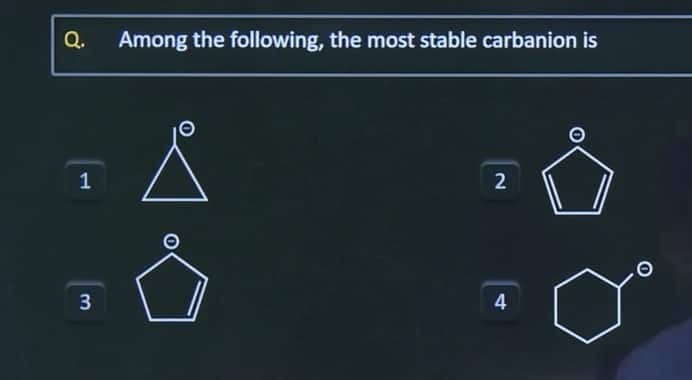If you passed 12th in 2025 and did not appear in JEE till now, then this is your eligibility:
-
JEE Main can be given for 3 consecutive years after 12th.
-
Each year has 2 sessions .
-
You are eligible in 2025, 2026 and 2027 .
-
Since you
JEE Mains 2025 January 23 Shift 1 Question Paper with Solutions - JEE Main is a key exam for students aspiring to build a career in engineering in India, serving as the gateway to top universities. The JEE Mains 2025 January 23 Shift 1 Question Paper and its solutions, will help candidates understand the exam’s format, identify important topics, and assess the level of difficulty after it is officially given. With changes in the exam structure, this year’s paper is expected to be highly competitive and challenging, continuing its legacy as one of the most important entrance tests in India.
This Story also Contains

|
Total Duration |
3 hours (180 minutes) |
|
Total Questions |
75 questions |
|
Maximum Marks |
300 marks |
|
Medium of Exam |
Available in 13 languages |
|
Mode of Exam |
Computer Based Test (CBT) |
|
Question Type |
MCQs and Numerical Value Based |
For Indian engineers aspiring to study engineering, JEE Main is an essential exam. Once the JEE Mains 2025 January 23 Shift 1 Question Paper and its solutions are released, they will offer candidates insight into the exam's level of challenge, important topics, and types of questions.
The following comprises of memory based questions from JEE Main 23 Jan Shift 1 Exam:
Q.1 Which of the following element doesn't lie on same period
(a) Osmium
(b) Iridium
(c) Palladium
(d) Platinum
Q.2
Which of the following pair of ions are same coloured?
$
\begin{aligned}
& 1 \mathrm{Ti}^{4+}, \mathrm{V}^{3+} \\
& 2 \mathrm{Cr}^{2+}, \mathrm{Cu}^{2+} \\
& 3 \mathrm{Cr}^{3+}, \mathrm{Ni}^{2+} \\
& 4 \mathrm{Mn}^{3+}, \mathrm{Fe}^{2+}
\end{aligned}
$
Q.3 Which of the following react with Hinsberg reagent?
(A) Aniline
(B) $\mathrm{N}, \mathrm{N}$-Dimethyl aniline
(C) Methyl amine
(D) $\mathrm{C}_6 \mathrm{H}_5 \mathrm{NHC}_6 \mathrm{H}_5$
. A only
. A and C only
. $A, C$ and $D$
. A and B only
Q.4
$
\mathrm{CH}_3 \mathrm{CH}_2 \mathrm{CH}=0 \xrightarrow[\text { Excess }]{\mathrm{HCHO}}[\mathrm{~A}]
$
Major product $[A]$ will be:
Q.5
Statement 1: Fructose can give tollens test even though it does not have aldehyde group
Statement 2: When reacted with base fructose can undergo rearrangement to produce aldehyde group
(1) If both Statement 1 and Statement 2 are true and the Statement 2 is the correct explanation of the assertion.
(2) If both Statement 1 and Statement 2 are true but Statement $\mathbf{2}$ is not the correct explanation of the assertion.
(3) If Statement 1 is true but Statement 2 is false.
(4) If the Statement 1 and Statement 2 both are false.
Q.6
Q)If for an arithmetic progression, if first term is $\mathbf{3}$ and sum of first four terms is equal to $\frac{1}{5}$ of the sum of next four terms, then the sum of first 20 terms is
(A) 1080
(B) 364
(C) $\mathbf{- 1 0 8 0}$
(D) -364
Q.7
If for the system of linear equations having infinite solutions
$
\begin{aligned}
& (\lambda-4) x+(\lambda-2) y+\lambda z=0 \\
& 2 x+3 y+5 z=0 \\
& x+2 y+6 z=0
\end{aligned}
$
then $\lambda^2+\lambda$ is
Q.8 Find the value of $\sin 70^{\circ}\left(\cot 10^{\circ} \cot 70^{\circ}-1\right)$
Q.9
The displacement of a particle as function of time is $x(t)=A(\sin )+B \cos ^2(t)+c t^2+D$. Find dimension of $\left(\frac{A B C}{D}\right)$
(A) $\mathrm{L}^2$
(B) $\mathrm{L}^{2 \mathrm{~T}} \mathrm{~T}^{-2}$
C $\mathrm{Lt}{ }^{-2}$
(D) $\mathrm{L}^3 \mathrm{~T}$
Q.10.Stat 1: hotter moves faster than cold water.
Stat 2: soap water have higher surface tension than fresh water
Q.11. Value of $\cos ^{-1}\left[\frac{12}{13} \cos x+\frac{5}{13} \sin x\right]$ is
$
\left(x \in\left[\frac{\pi}{2}, \pi\right]\right)
$
$1 \quad x+\tan ^{-1} \frac{12}{13}$
$2 x-\tan ^{-1} \frac{12}{13}$
$3 \quad x-\tan ^{-1} \frac{5}{12}$
$4 \quad x+\tan ^{-1}\left(\frac{4}{5}\right)$
Q.12 If angles of projection for two projectiles are $30^{\circ}$ and $60^{\circ}$ then the ratio of velocities at maximum height is.
Q.13 If $10^{21}$ molecules are removed from $\times \mathrm{mg}$ of $\mathrm{CO}_2(\mathrm{~g})$, then $2.4 \times 10^{-3}$ moles are left. Calculate the value of $x$
Q.14 Area of the larger region bounded by curves $y=|x-1|$ and $x^2+y^2=25$ is
Q.15
If $f(x)$ is continuous at $x=0$, where
$
f(x)=\left\{\begin{array}{cl}
\frac{2}{x}\left(\sin \left(k_1+1\right) x+\sin \left(k_2+1\right) x\right) & x<0 \\
\frac{4}{x} \log \left[\frac{k_2 x+1}{k_1 x+1}\right] & x=0 \\
& x>0
\end{array}\right.
$
Then $k_1^2+k_2^2$ is
Q.16 $q_1=3 \quad S_4=\frac{1}{4}\left(S_8-S_4\right)$ find $S_2=$ ?
Q.17 which of the following Can show face-mer Isomes
a) $\mathrm{Co}\left[(\mathrm{en})_2 \mathrm{Cl}_2\right]$
b) $\left[\mathrm{Co}\left(\mathrm{NH}_3\right)_4 \mathrm{Cl}_2\right]$
c) $\left[\mathrm{Co}\left(\mathrm{H}_2 \mathrm{O}\right)_6\right]_1 \mathrm{X}$
d) $\left[\mathrm{Co}\left(\mathrm{NH}_3\right)_3 \mathrm{Cl}_3\right]$



Previous year's question papers play a crucial role in JEE Main preparation. By practising them, you can better understand the exam pattern and the type of questions that might appear in JEE Mains 2025. Reviewing past papers will help you become familiar with the format and difficulty level, enhancing your readiness for the upcoming exam. Make sure to check the previous year’s question papers here for valuable practice material.
Here is a detailed analysis of the JEE Main previous year analysis:
2. Physics Section
Recognized as Institute of Eminence by Govt. of India | NAAC ‘A++’ Grade | Upto 75% Scholarships | Application Deadline: 15th Jan
100% Placement Record | Highest CTC 54 LPA | NAAC A++ Accredited | Ranked #62 in India by NIRF Ranking 2025 | JEE & JET Scores Accepted
As compared to previous years, the structure of the JEE Main 2025 January 23 shift 1 exam is expected to be organized in the same manner as the major emphasis on the distribution of questions. Mathematics will remain a focus of Calculus and Algebra, and Mechanics and Electromagnetism will dominate the Physics portion. Hopefully, Organic Chemistry will continue to be the largest section in Chemistry as it was in the previous years.
Frequently Asked Questions (FAQs)
The JEE Main 2025 January 23 Shift 1 Question Paper and Solutions will be provided here after the conclusion of the exam. Students and teachers can access the question paper in PDF format.
The JEE Main 2025 January 23 Shift 1 exam is expected to have a moderate difficulty level and a balanced distribution of easy, moderate, and difficult questions across all sections. Mathematics and Physics are likely to be comparatively challenging and the Chemistry section is expected to be easier for those with a strong foundation in Organic Chemistry.
On Question asked by student community
You can get free mock tests for JEE 2026 on the Careers360 website. The mock tests are based on the latest exam pattern and help in understanding the level of questions and time management. You just need to register and start attempting the tests online.
Direct link for JEE mock
Hello,
If you passed 12th in 2025 and did not appear in JEE till now, then this is your eligibility:
JEE Main can be given for 3 consecutive years after 12th.
Each year has 2 sessions .
You are eligible in 2025, 2026 and 2027 .
Since you
Hello,
For JEE (for IT / engineering) :
10th percentage
There is no fixed minimum percentage needed in Class 10 to prepare for JEE.
You just need to pass Class 10 .
Important part is Class 12
You must study Physics, Chemistry, and Mathematics in Class 11 and 12 .
Hello there,
Understanding and solving different question papers is one of the best practices for preparation ,especially when it comes to JEE. It gives you a proper understanding of the exam pattern, important topics to cover, and the marking scheme.
Here is the link attached from the official website of
Hello
You're a student in the medical stream, and you should have studied Physics, Chemistry, Mathematics, and Biology subjects; then you're eligible for the JEE Mains exam, because the eligibility for the JEE Mains exam is that you must have studied Physics, Chemistry, and Mathematics subjects. You should focus heavily
Among top 100 Universities Globally in the Times Higher Education (THE) Interdisciplinary Science Rankings 2026
National level exam conducted by VIT University, Vellore | Ranked #16 by NIRF for Engg. | NAAC A++ Accredited
Recognized as Institute of Eminence by Govt. of India | NAAC ‘A++’ Grade | Upto 75% Scholarships | Application Deadline: 15th Jan
Ranked #43 among Engineering colleges in India by NIRF | Highest Package 1.3 CR , 100% Placements
100% Placement Record | Highest CTC 54 LPA | NAAC A++ Accredited | Ranked #62 in India by NIRF Ranking 2025 | JEE & JET Scores Accepted
NAAC A+ & NBA Accredited | QS I-Gauge Gold rated University | Highest CTC 52 LPA | 300+ Companies | Avail Scholarships Application Deadline: 28th Feb’26